The high-earning real estate professionals have something in common—they take a different approach, a different path to success than traditionally known.
While the technology, marketing, and sales tactics available to the majority of agents are mostly the same, they take a different approach with each tool and resource available to them. They can harness the power of different real estate marketing strategies based on the target locations & audience, available tools, and their communication strengths.
Some agents may find success through suburbs, while others may identify vacation properties to be the most lucrative segment. While some agents use email marketing and some use SMS, others may use both as part of their digital marketing strategy.
The moral of the story is, they’ve all found something that works for them, and you gotta find your own. This is where this guide helps you to understand the different real estate marketing tools available while delving deeper into text message marketing.

Building a Long-Term Sustainable Marketing Plan
The first step on the path to real estate marketing success is to define and build a long-term, sustainable marketing plan.
An effective marketing plan involves understanding your target market, setting clear and SMART goals, selecting the right channels, optimizing your online presence, and measuring the outcomes, which allows you to prioritize and tailor your marketing plan.
That said, here’s a stepwise process to building a long-term, sustainable marketing plan:
1. Understand Your Target Market
Understanding your target market is the founding stone for a real estate marketing plan. You’re required to do thorough market research to understand their preferences and pain points when it comes to buying, selling, and renting properties.
You can also segment your target market based on their demographics (age, income, and location), psychographics (lifestyle, preferences), and behavior (buying habits, and other factors). Doing so will help you tailor your marketing efforts to address the specific needs and interests of your target market.
2. Embrace the Digital Marketing Platforms
Digital marketing platforms are now an integral part of new-age marketing for real estate businesses. It allows you to reach wider audiences and increase your business’s visibility on search engines, like Google, Bing, etc., and social media platforms, like Instagram, LinkedIn, etc.
Additionally, you can use direct marketing channels, such as email and SMS marketing tools to reach your customers directly where they spend most time of their day—their mobile devices. Email and SMS campaigns can help you nurture your leads and keep them informed about new listings, open-house visits, market trends, and many more things.
Also, use local marketing tools to build visibility for local search terms, such as “real estate agency near me”, making it easier for potential buyers to find you.
3. Set Clear Goals for Your Marketing Efforts
What goals do you want to achieve with your real estate marketing efforts? Are they relevant, achievable, measurable, and time-bound?
Not only devices but your goals should be SMART too. SMART goals are Specific, Measurable, Achievable, Relevant, and Time-Bound. An example of a SMART goal for a real estate agent could be “Increase new leads by 30% in the next quarter.”
As you can see, it’s clear and specific on what you want to achieve, the timeline to achieve it, and it’s relevant and measurable for your real estate marketing efforts. You can establish metrics to track progress, ensuring that these are realistic and achievable, and align with your overall real estate business growth.
4. Harness the Power of Visual Content
Visual content has been the prime weapon of modern-age marketers to engage audiences with their content and brand. Specifically, videos, memes, GIFs, and images have been the most helpful across industry domains.
By creating engaging visual content, you can attract potential customers to showcase the portfolio of properties, and provide valuable information. Videos, especially, allow you to show properties in a more engaging and interactive way.
You can create virtual tours, share property walkthroughs, and provide clients with a better understanding of the properties you are selling. This can help your real estate business stand out from the competition and attract more leads.
5. Optimize for Local SEO
There are a few things you can do to optimize your local SEO presence. Start by creating or claiming your Google Business Profile and fill in the name, address, phone number, operational hours, website URL, photos, business category, and other details as accurately as possible.
Optimize your website content with local SEO keywords to rank higher among local searchers. Additionally, build citations for your local business and create profiles on platforms such as Yelp, Yellowpages, Facebook, Apple Maps, Bing Places, and others.
Monitor your local SEO performance and make necessary adjustments to ensure your strategies remain effective in the long term.
6. Measure Outcomes and Adjust Your Strategies
Regularly monitor your marketing efforts and analyze how they have affected your business’s performance. You can use Google Analytics, social media insights, or the built-in analytics report in the CRM, email, or SMS marketing tool you use.
Identify and track key metrics such as traffic, leads, engagement, responses, and conversions from your marketing efforts. Analyze these data to find common patterns, trends, strengths, and weaknesses to understand and refine what works and what doesn’t.
This can help you stay updated with the expected outcomes for the efforts you have put in and achieve your long-term goals for real estate marketing.

Getting the Right Tools and Resources in Place
Before getting tools and resources, examine what you already have. Do you have the right tools for real estate success? Apart from computers, smartphones, and tablets, you’ll require several other tools and resources to speed up your sales cycle and turn visitors into leads and eventually a client.
Here’s a list of resources and tools that real estate agents should swear by:
1. A Responsive Website for Property Listing
A responsive, mobile-friendly website allows you to list new properties as and when they become available, provide users with ease of navigation, and be integrated with multiple listing service providers. Having such functionalities in your website makes it easy for you to generate new leads.
A well-developed and user-friendly website is essential to showcase properties and provide accurate information to potential clients. A website designed specifically for real estate agencies can help establish credibility and professionalism, making it a crucial resource for real estate agents.
2. Customer Relationship Management Software
CRM systems help you organize your lead information and let you see where each of your leads is in their buying and selling process. This information enables you to know who needs more nurturing, who is ready for a follow-up email or SMS, and who requires an in-person visit.
CRM systems for efficient lead management may sound scary, however, it can be straightforward to learn and use. Specialized CRM tools, like Close, Liondesk, Wise Agent, and others, can help you prospect, store information, send relevant content, and do much more.
3. Email Marketing Tools
Email marketing is another crucial tool for real estate marketing to reach a vast audience, nurture leads, foster connections, and drive more sales opportunities. It is an indispensable tool for real estate agents and an integral part of the industry.
To maximize your efforts, it’s essential to build a quality list of email subscribers who have a genuine interest in your services. Once you have the list of interested prospects, start sending them compelling email content. The engaging and informative email content is proven to resonate with your audience and nurture them down to your sales funnel for informed decision-making.
You can even implement automation and drip campaigns in email marketing for relationship building and lead nurturing. Also, it’s an excellent way to promote your property listings and open houses by sending visual content to captivate your prospects.
4. SMS Marketing Tools
SMS marketing is not just effective but also ideal for real estate agents. While email marketing is convenient as people check their emails several times a day, the thing is, they arrive in inboxes that are already full. As per our findings, people receive an average of 100+ emails but receive only 30+ SMS in a day.
Another report found that 93% of real estate agents prefer text messages, 90% prefer telephone, and 89% prefer email for communicating with clients. Also, SMS has a higher open and read rate than email marketing which makes it a more effective marketing channel to try.
Furthermore, exceptional deliverability, high open & response rate, CTR, and other benefits make SMS marketing hard to overlook for real estate agents. With SMS, you can send personalized and relevant communication, book appointments, and save time and money with automated text messaging tools like Textdrip.

Create Your Own Real Estate Marketing Strategy
1. Set Your Marketing Budget
Statista report found that real estate marketing is projected to grow at a 4.51% CAGR to reach $142.9 trillion by 2028.
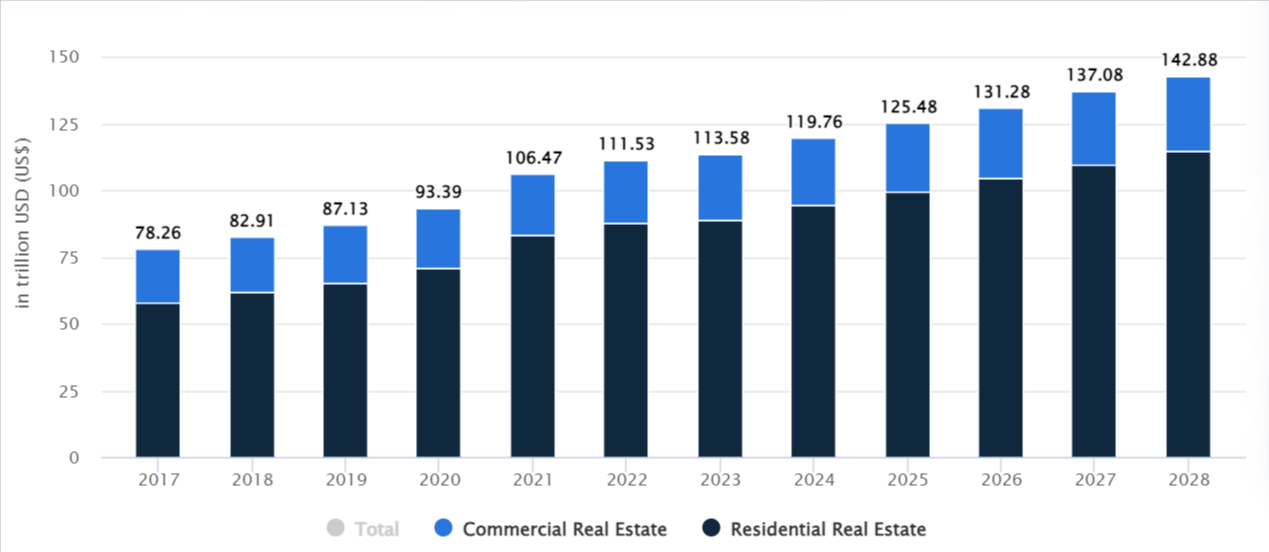
Another report found that real estate marketing spending is somewhere between $4.2 billion to $16.2 billion with the average spending per agent being $12,000 and median spending closer to $3000 to 6000. Additionally, the report highlighted that most agents commit 6-13% of net commissions to marketing, and the average marketing spend per home sold is between $700 to $2,700.
This can make your head shake in disbelief at how agents and brokers are allocating so much money for real estate marketing. Well, the truth is, as long as you are closing more deals and earning more income from your marketing activities, you want to invest more and test new avenues.
And this requires allocating a budget for the activities you want to try. To do so, here’s what you can do:
-
Determine your business capital for the next quarter or year
-
Inspect the channels that have worked for you previously
-
New avenues and sales channels to try
-
Based on these insights allocate a budget for marketing activities
2. Define Your Buyer Personas
The next activity is to clarify the primary audience you want to target with your real estate marketing efforts. Buyer personas are the traits and characteristics your past, current, and potential customers have. This can include demographics, behavior, preferences, and other details.
These characteristics should be at the front and center of your marketing activities and the content you produce. For instance, you can tailor your marketing and sales efforts for millennials who prefer urban centers or for Baby Boomers who prefer countryside or oceanfront properties.
Ideally, it’s best to have multiple buyer personas, considering the nature of the business, so that you can tailor your marketing efforts and increase your chances of building a successful business. Additionally, analyze and re-analyze your buyer personas often and adjust them accordingly for years to come to yield the best results possible.
3. Build a Foundation for Your Marketing
While you may have an understanding of the benefits of having a website in the digital-first world, how do you know if it has built a solid foundation for your marketing? Is your SEO properly set up to drive more organic traffic?
Real estate agents looking to expand their earnings should also have a better understanding of the following criteria to ensure that they have built a solid foundation:
-
The website offers a great user experience
-
It has an appealing design and visuals
-
Showing an increase in the number of users month-over-month
-
High-quality and informative content that ranks well
-
Has a good number of backlinks, citations, and business profiles
-
Optimized for long-tail, local, and focused keywords that customers search for
-
Gated/valuable resources to capture lead information
4. Selecting the Core Marketing Activities
As explained earlier, apart from optimizing your website for online search, you could also incorporate social media marketing, email marketing, SMS marketing, and other strategies that work for real estate lead generation.
Today, the marketing realm has expanded to offer several different opportunities to get in front of your target audience and achieve your business goals. Since you know your brand and your customers better than anyone else, we recommend that you pick a few core marketing activities from the list below:
-
Create a series of blogs or articles
-
Become a thought leader in your industry
-
Share news, trends, and other useful information on social media
-
Create educational videos and content for your brand
-
Send nurturing emails to compel users to take action
-
Share quick updates and alerts via the SMS channel

Setting Up Your Real Estate Text Marketing
If you have reached this section of this guide, it means you want to set up your own text messaging account. While there are many great platforms available in the market, Textdrip stands out with its cost-effective pricing structure that suits different business types.
Here’s how to get started with setting up a text marketing account for a real estate business:
1. Sign Up for Business Texting Software
Textdrip is one of the best business texting software. We are not the ones saying it, our customers who left generous reviews on several platforms have said the same thing. For instance, here’s one review on Capterra that talks about how the customer was able to achieve 98% deliverability with Textdrip.
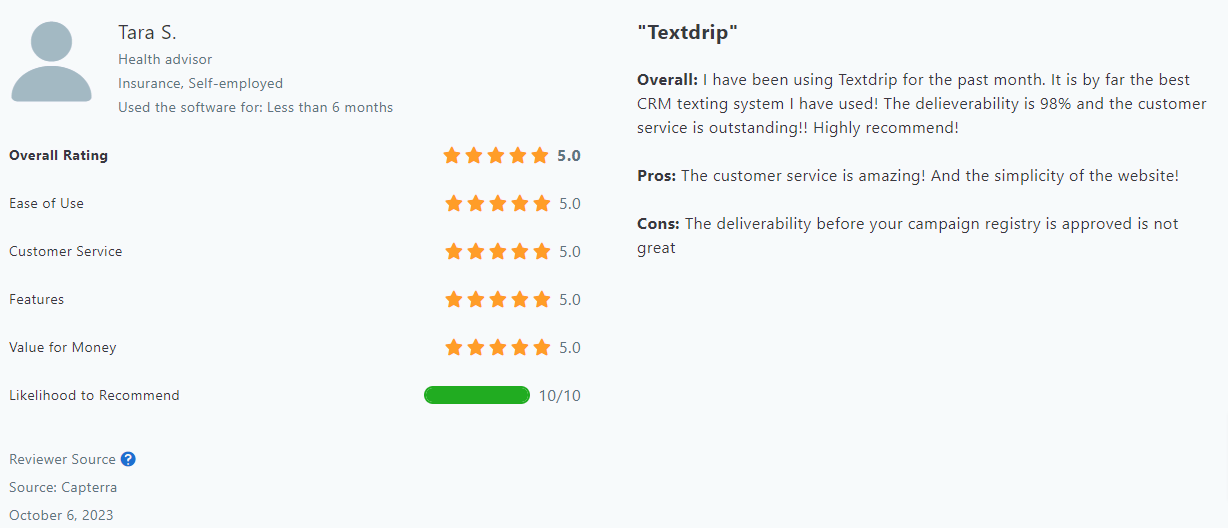
Similar to these, many other customers have left reviews for Textdrip on G2, Capterra, Trustpilot, and other review platforms that make Textdrip stand apart from the rest.
Textdrip is not only the most cost-effective, but it’s one of the user-friendly text marketing tools with features like,
-
3rd-party integrations
-
And many more
These features allow you to not only automate your business texting but also streamline your communication with clients. Additionally, you get 10-DLC compliance that ensures your bulk text messages are sent out uninterruptedly.
2. Build Your Contact List & Collect Opt-ins
The #1 rule of sending texts to your real estate leads and contacts is to gain their explicit permission. You should have their express written permission to send text messages before you can kick-start your SMS marketing campaigns. To collect their opt-ins and build your contact list, here’s what you can do:
-
Build a dedicated landing page to collect user opt-ins using the page builder within Textdrip
-
Use social media platforms to promote your SMS subscription
-
Offer incentives when you ask your leads to join your SMS list
-
Promote SMS sign-up through emails
Once you have set up the process to collect user opt-ins, the next step is to segment them by creating the following recommended groups/campaigns or others as you wish:
-
Buyers
-
Sellers
-
Renters
-
Agencies
The more precise your segmentation is the more relevant messages you will be able to send to your target audience. By sending relevant messages that resonate with your real estate clients, you can easily instill trust with value-based SMS marketing.
3. Set Up Automated Nurturing Campaigns
The next step in setting up your real estate texting account is to create your first automated campaigns to nurture your segmented prospects. Using the drip text messaging features of Textdrip, you can easily create a series of text messages that are sent at predetermined intervals to a large group of recipients.
The feature allows you to set the duration in minutes, hours, and days between two successive. If in the case where one of the users in your campaigns replies to your automated nurturing messages, they’ll be moved to the inbox of the platform to take the conversation further.
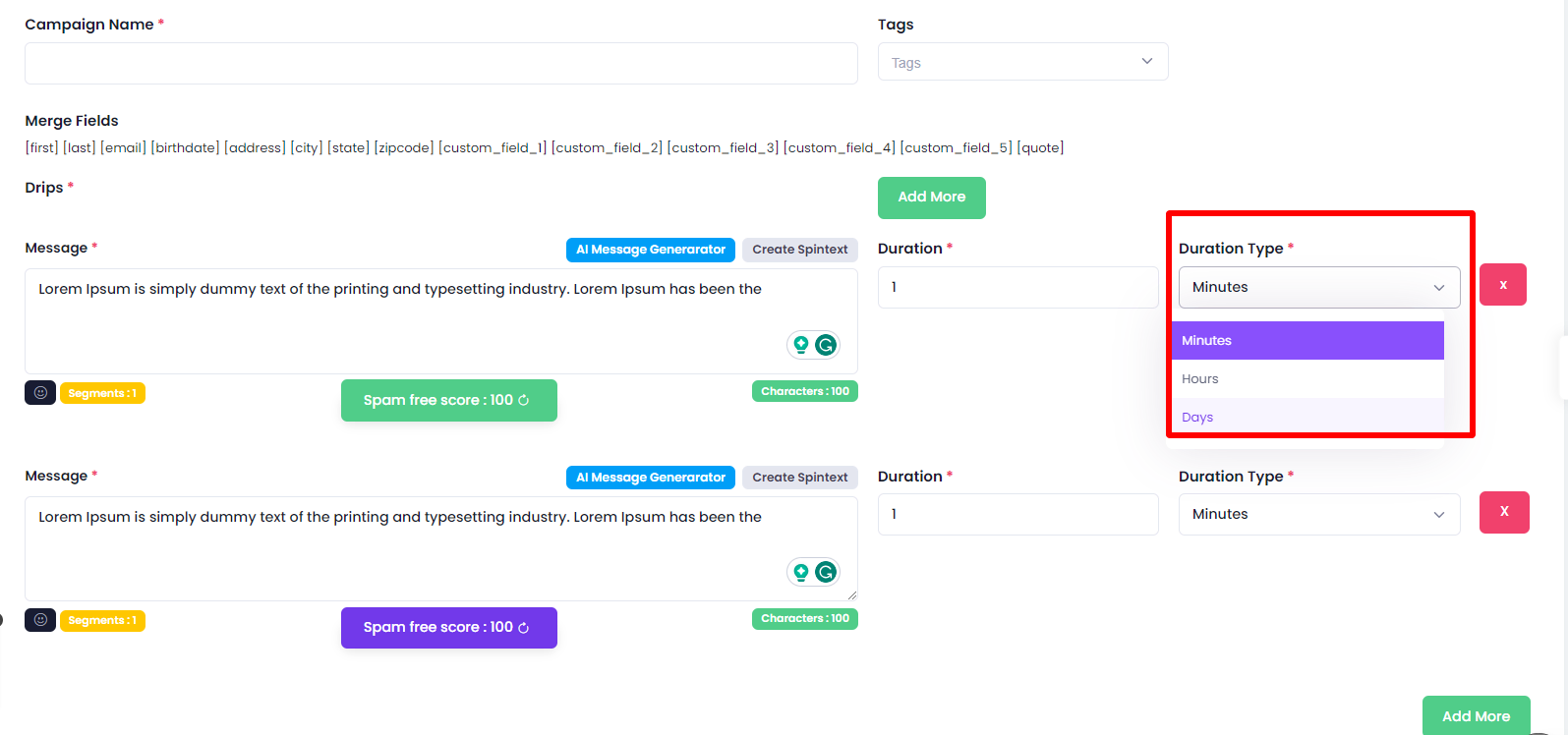
Textdrip even goes one step further to allow you to generate compelling text messages with an AI message generator or paraphrase your messages and send unique text messages to each recipient. Thus, setting up your real estate nurturing campaigns is easy with Textdrip.
4. Import Your Contacts
After you have created your automated nurturing campaigns, it’s time to upload your contacts to the platform and assign them to the desired campaigns. You can create multiple campaigns, for instance, for buyers, sellers, renters, and agencies, and segment your contacts while importing.
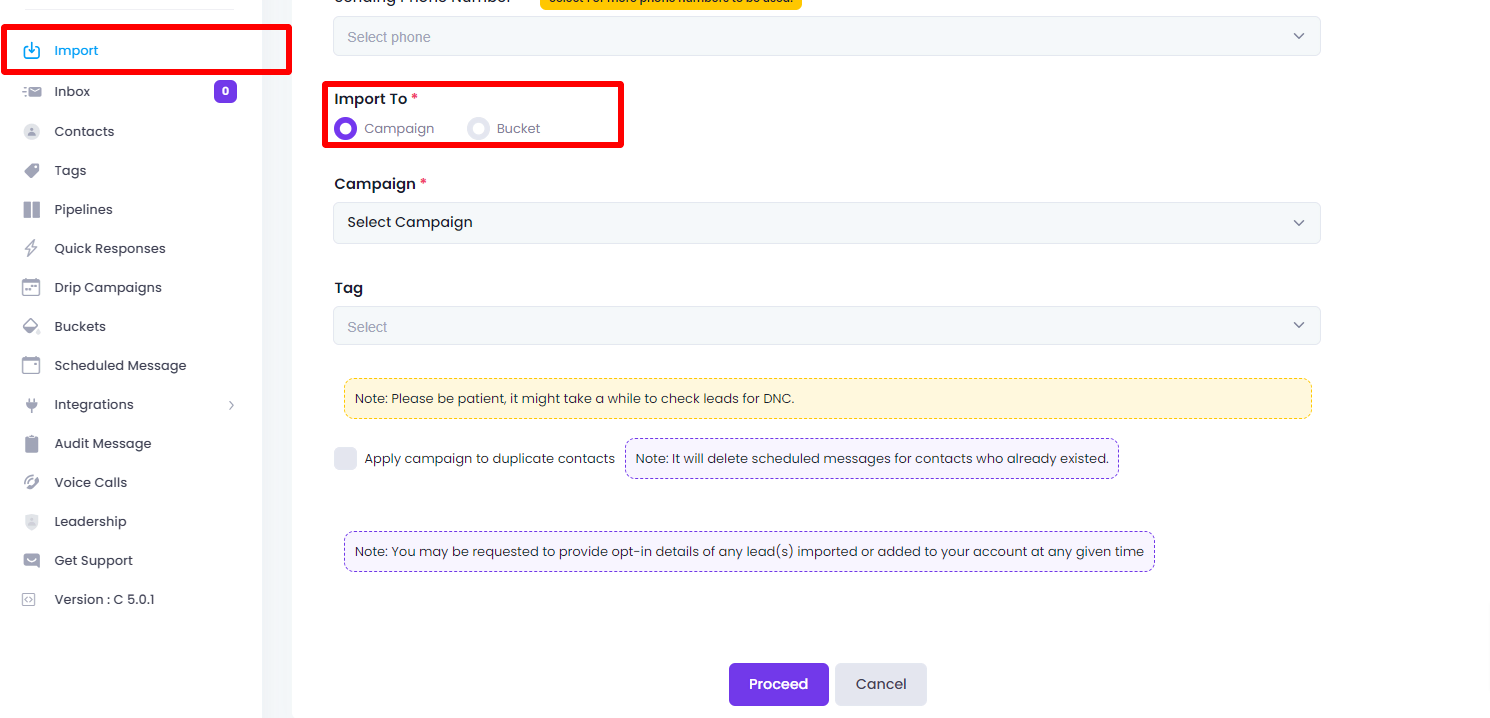
To do so, create separate CSV files that contain contact information of different user types and upload them individually to assign them to relevant campaigns. This enables your real estate business to send tailored messages to user preferences, needs, behavior, and demographics and compel them to take action.
Keep note that Textdrip allows you to upload up to 5000 contacts in one instance, however, you can upload as many contacts as you want. Segmenting your real estate prospects at the import stage allows you to send targeted messages to the right audiences.
5. Add Value to Your Messages & Test Everything Beforehand
Now that you have added contacts to your business texting platform, it’s time to make your campaigns live. Since this would be your first interaction with your prospects, instead of sending a generic text, provide some tangible value.
For instance, invite recipients for open-house visits or send them a list of relevant properties that they have shown interest in while having telephone or in-person conversations. Show them the value your users tend to get if they remain subscribed to your SMS marketing campaigns.
Another important aspect is to test everything beforehand by sending text messages to your known associates. Doing so allows you to verify your content, links, and other elements are working as expected so you can iron out any issues before sending text messages to real clients.

Types of Real Estate Marketing Text Messages You Can Send
While you want to make your text message campaigns live as soon as possible, often real estate agents wonder what should I write in text messages. Generating strong sales leads is as important as sending them the right text message that compels them to take action.
Here are a few text message types and examples you can send to your prospects:
1. Send New Property Alerts & Details
Text messages are instant, and with Textdrip, you can achieve 98% deliverability. This ensures that your text messages are sent to almost all your contacts immediately, which makes it a great marketing channel to send instant property alerts and new lists.
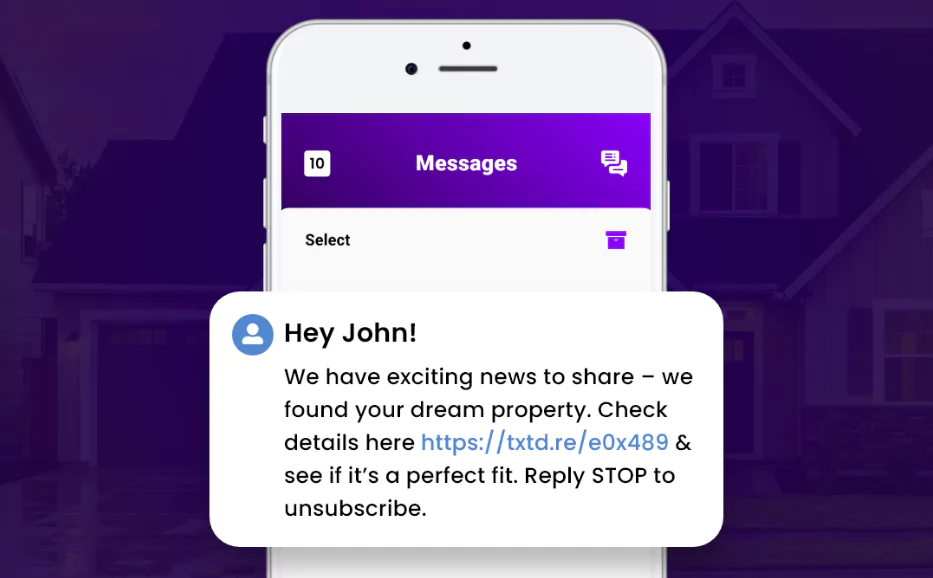
Sending instant alerts about new property listings would be appreciated by your prospects and they’ll love the convenience of getting new lists instantly on their mobiles. As you can see in the above example, the text message is personalized with the buyer’s name and would relate to his journey of finding a dream property.
You can even customize your message to provide a filtered list of properties in neighborhood areas that are prime locations for your prospects. If you have segmented your prospects appropriately, sending them tailored property listings would become easier.
2. Schedule Showing
The next SMS type you can send to your prospects is to fix a meeting or schedule a showing with clients. When your prospects show interest in your property or an open-house invitation, you can send them a quick message with the necessary information for scheduling a showing.
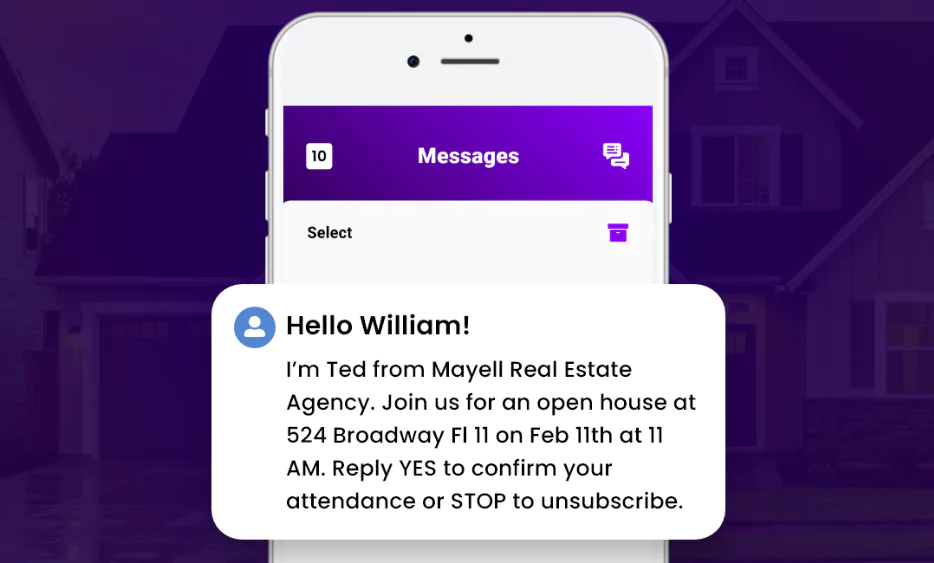
As seen in the above example, provide your prospects with the necessary information for showing and ask them to reply with YES to confirm their availability. This ensures that your prospects are aware of your showing details and can reach out to you if they want to schedule an appointment.
The crucial element of these types of SMS is including a compelling call-to-action (CTA). When you make it simple for your prospect to take action, such as asking them to reply ‘YES’, they are more likely to take action and schedule a showing with you.
Additionally, you can provide scheduling links for prospects to book an appointment in the available slots. Just include those links as CTA in your text messages to allow buyers to book a timeslot for showing.
3. Send Automated Reminders
Let’s say 768 out of 2200 contacts have scheduled an appointment for showing but only around 72 people show up at the right time and the right spot. Often it slips out of people’s minds that they have scheduled a showing with your real estate agency.
This leads to a reduced show-up rate and automated reminders are perfect to keep these scheduled showing appointments on top of the prospects’ minds. With the scheduled messaging feature in Textdrip, you can easily create automated reminders to send at specific times before the showing.
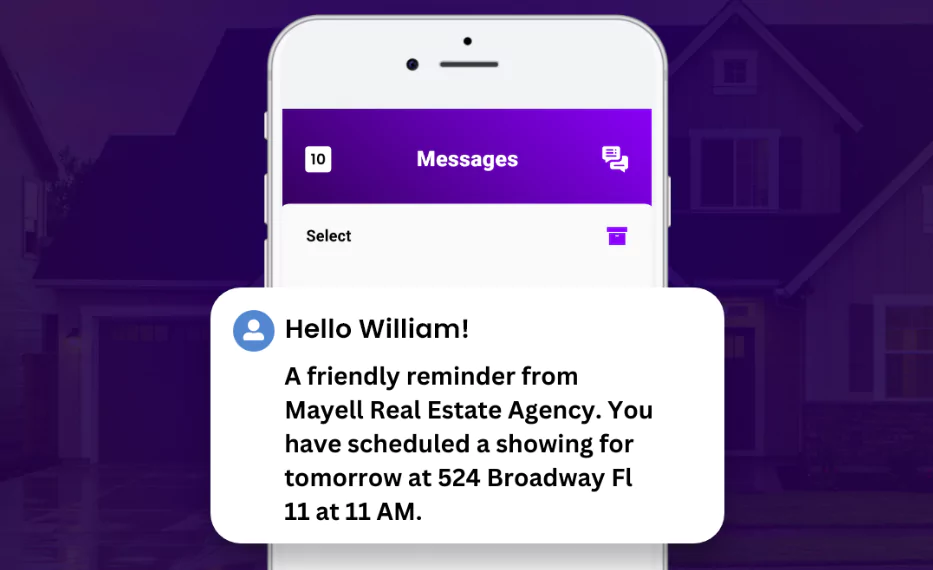
Such simple reminders are enough to keep your prospects aware of their property showing appointments with your real estate agency.
4. Send Follow-up Texts After Showing
Your property showing appointments have worked wonders and people have actually turned up to the location. Some might not show interest or others would get busy with their life and forget if they had visited the properties.
Follow-up text messages allow you to reconnect with contacts with whom you have lost touch and ask them to check out your new property listings, video tours, or something else. Sending simple follow-up texts would also ensure that your prospects stay engaged with your real estate agency and ask for your help whenever needed.
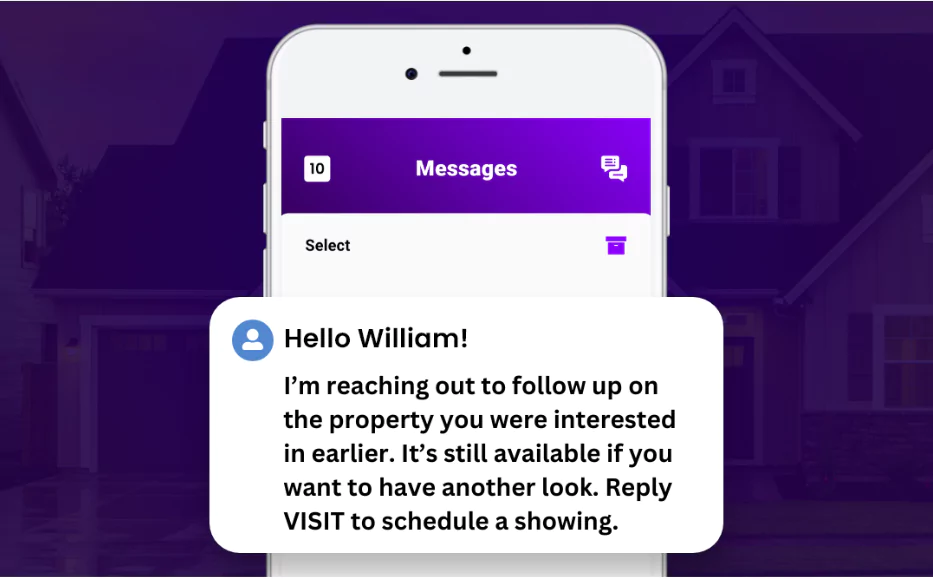
Since text messages have high deliverability and open rates, the follow-up texts are likely to get noticed by your prospects and they may even respond to them. Additionally, it’s a great tool to nurture your prospects and lead them to the final step of the process.
5. Send Documentation & Other SMS Types
Other types of SMS messages include offer acceptance texts, mortgage information texts, documents required texts, and others. If everything goes according to plan, your clients will move forward with the purchase and your job is to keep them updated throughout the process.
Many of these buyers would be first-timers and you want to make it as smooth as possible for them to purchase the desired property. You want to make sure that they have a great experience navigating through the tedious paperwork process and get your assistance at each step. By utilizing several real estate SMS examples & templates, you can keep your prospects in the loop at all times.

Remember to Bring It All Home
Real estate is a highly volatile industry and agents need the right tools that help them with immediate, instant reach. SMS can help take their real estate marketing game a notch higher with more focus on branding and nurturing your clients.
To harness the power of the SMS channel, all the real estate agencies need to define the necessary steps beforehand. You need to build a long-term sustainable marketing plan, adopt the right tools and resources for growth, create your own real estate marketing strategy, set up the channels including text marketing, and define the types of different communications you can send to your clients.
To make it easy for you to get on board, Textdrip offers a Upto 30 Days free trial with Upto 2500 complimentary credits to experience the platform inside out. You can also book a free demo with us to see the difference Textdrip can bring to your business.
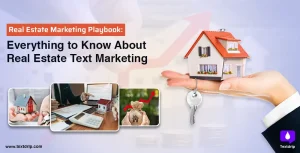
![Bulk SMS Marketing Starter Guide — How to Create Bulk SMS Drip Campaign? [Infographic]](https://textdrip.com/wp-content/uploads/2024/07/BULK-SMS-MARKETING-STARTER-GUIDE-1-300x153.webp)











